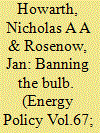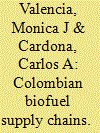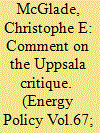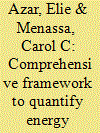|
|
|
Sort Order |
|
|
|
Items / Page
|
|
|
|
|
|
|
| Srl | Item |
| 1 |
ID:
128416


|
|
|
|
|
| Publication |
2014.
|
| Summary/Abstract |
Air-conditioners and antibiotics are two technologies that have both been traditionally framed around individual health and comfort needs, despite aspects of their use contributing to social health problems. The imprudent use of antibiotics is threatening the capacity of the healthcare system internationally. Similarly, in Australia the increasing reliance on air-conditioning to maintain thermal comfort is contributing to rising peak demand and electricity prices, and is placing an inequitable health and financial burden on vulnerable heat-stressed households. This paper analyses policy responses to these problems through the lens of social practice theory. In the health sector, campaigns are attempting to emphasise the social health implications of antibiotic use. In considering this approach in relation to the problem of air-conditioned cooling and how to change the ways in which people keep cool during peak times, our analysis draws on interviews with 80 Australian households. We find that the problem of peak electricity demand may be reduced through attention to the social health implications of air-conditioned cooling on very hot days. We conclude that social practice theory offers a fruitful analytical route for identifying new avenues for research and informing policy responses to emerging health and environmental problems.
|
|
|
|
|
|
|
|
|
|
|
|
|
|
|
|
| 2 |
ID:
128441


|
|
|
|
|
| Publication |
2014.
|
| Summary/Abstract |
Many of the major greenhouse gas emitting countries have planned and/or implemented domestic mitigation policies, such as carbon taxes, feed-in tariffs, or standards. This study analyses whether the most effective national climate and energy policies are sufficient to stay on track for meeting the emission reduction proposals (pledges) that countries made for 2020. The analysis shows that domestic policies of India, China and Russia are projected to lead to lower emission levels than the pledged levels. Australia's and the EU's nationally legally binding policy framework is likely to deliver their unconditional pledges, but not the conditional ones. The situation is rather unclear for Japan, South Korea, Brazil and Indonesia. We project that policies of Canada and the USA will reduce 2020 emission levels, but additional policies are probably needed to deliver their pledges in full. The analysis also shows that countries are implementing policies or targets in various areas to a varying degree: all major countries have set renewable energy targets; many have recently implemented efficiency standards for cars, and new emission trading systems are emerging.
|
|
|
|
|
|
|
|
|
|
|
|
|
|
|
|
| 3 |
ID:
128459


|
|
|
|
|
| Publication |
2014.
|
| Summary/Abstract |
To understand the impact of environmental value, ecological lifestyle, customer innovativeness on customer intention to install solar power system (SPS) in their private houses, an empirical model was proposed. Customer innovativeness was treated as a second-order construct with two first-order dimensions, with each of the latter being measured by means of reflective indicators. Using structural equation modeling, data collected from 203 college students and faculties at a University of Taiwan were tested against the model. We found that environmental value has a positive impact on ecological lifestyle and SPS install intention. Although ecological lifestyle associates positively with SPS install intention, the effect disappears when environmental value is included in the model. The effect of customer innovativeness on SPS install intention results from the tendency of customer novelty seeking, while the impact of customer independent judgment-making on SPS install intention is insignificant. The model explained 76% of the total variations within SPS install intention. Managerial implications for promoting of SPS are considered, and suggestions for further research provided.
|
|
|
|
|
|
|
|
|
|
|
|
|
|
|
|
| 4 |
ID:
128423


|
|
|
|
|
| Publication |
2014.
|
| Summary/Abstract |
Much academic attention has been directed at analysing energy efficiency investments through the lens of 'behavioural failure'. These studies have challenged the neoclassical framing of regulation which emphasises the efficiency benefits of price based policy, underpinned by the notion of rational individual self-mastery. The increasing use of a regulatory ban on electric lamps in many countries is one of the most recent and high profile flash points in this dialectic of 'freedom-versus-the-state' in the public policy discourse. This paper interrogates this debate through a study of electric lamp diffusion in Germany. It is argued that neoclassical theory and equilibrium analysis is inadequate as a tool for policy analysis as it takes the formation of market institutions, such as existing regulations, for granted. Further still, it may be prone to encourage idealistic debates around such grand narratives which may in practice simply serve those who benefit most from the status quo. Instead we argue for an evolutionary approach which we suggest offers a more pragmatic framing tool which focuses on the formation of market institutions in light of shifting social norms and political goals-in our case, progress towards energy efficiency and environmental goals.
|
|
|
|
|
|
|
|
|
|
|
|
|
|
|
|
| 5 |
ID:
128372


|
|
|
|
|
| Publication |
2014.
|
| Summary/Abstract |
This study employs a multiple-case study method, identifies barriers to the adoption of low carbon production, and categorizes these barriers into four domains: structural, regulatory, cultural, and contextual. The two most frequently mentioned barriers were "lack of financial incentives to stimulate low carbon innovation" and "lack of a common definition of low carbon production". The two least frequently mentioned barriers were "silos exist between planning and production" and "operational staff are often physically separated from planning staff, which isolates them from planning decisions". Furthermore, contextual barriers were significantly related to structural and regulatory barriers, while regulatory barriers were significantly related to structural barriers. Larger firms tend to have a more structured organization and lower perceptions of the employment term barrier. However, larger structured organizations have been affected by a long history of a planning-oriented economy and hence tend to have inflexible hierarchical systems. In contrast, small firms have hierarchical systems with less effect on low carbon production than those of large enterprises. Another interesting trend is the direct size effect on cultural barriers, which is evident in a culture of risk aversion, as well as the lack of low carbon technology and the existence of silos between planning and production.
|
|
|
|
|
|
|
|
|
|
|
|
|
|
|
|
| 6 |
ID:
128370


|
|
|
|
|
| Publication |
2014.
|
| Summary/Abstract |
International shipping transports around 90% of global commerce and is of major importance for the global economy. Whilst it is the most efficient and environmentally friendly mode of transport, CO2 emissions from shipping activities still account for an estimated 3% of global emissions. One means of significantly reducing fuel consumption and thereby GHG emissions from shipping are wind propulsion technologies (i.e. towing kites, Flettner rotors and sails) - yet current market uptake is very low. Therefore, the aim of this article is to identify the barriers and drivers for the uptake of wind propulsion technologies. To this end, the theoretical approach of technological innovation systems is adopted. This approach combines structural system components with so-called system functions which represent the dynamics underlying structural changes in the system. The fulfillment of these functions is considered important for the development and diffusion of innovations. Based on newspaper and academic articles, online expert interviews and semi-structured interviews, the level of function fulfillment is evaluated, followed by the identification of structural drivers and barriers influencing function fulfillment. Third, the possibilities to influence these drivers and barriers are discussed.
|
|
|
|
|
|
|
|
|
|
|
|
|
|
|
|
| 7 |
ID:
128336


|
|
|
|
|
| Publication |
2014.
|
| Summary/Abstract |
Axon et al., (2012) argue that maximizing the potential for energy efficiency and demand reduction in tenanted commercial properties requires a "building communities" approach. This paper develops and extends Axon et al.'s proposed framework in two ways. First, by extending its applicability from tenanted to owner-occupied properties. Second, by situating it within the literature related to organizational culture, occupant behaviours, and technology adoption. The paper begins with a brief review of the existing research on people, energy and commercial buildings. This literature tends to address either organizational choices, or occupant behavior, but it rarely crosses the analytical boundaries between these two groups. The paper then explores these different levels of analysis within a 3Cs - "concern, capacity, and conditions" - framework, which was developed to describe and distinguish organizational responses to an energy crisis. The combination of the "building communities" and 3Cs frames reveals gaps and grey areas between organizational culture, occupant behaviour, and technology adoption where further conservation opportunities may lie. These understudied areas suggest that there may be "social potential" for change that is between and beyond the frames used by previous research in the field.
|
|
|
|
|
|
|
|
|
|
|
|
|
|
|
|
| 8 |
ID:
128447


|
|
|
|
|
| Publication |
2014.
|
| Summary/Abstract |
We analyze carbon intensity performance at firm level and the effectiveness of the Swedish CO2 tax. Carbon intensity performance is derived from a production technology and measured as changes in the CO2 emission-output production ratio. As one of the first countries to introduce a CO2 tax in 1991, Sweden serves as an appropriate "test bench" for analyzing the effectiveness of climate policy in general. Firm level data from Swedish manufacturing spanning over the period 1990-2004 is used for the analysis. Results show that EP has improved in all the sectors and there is an evidence of decoupling of output production growth and CO2 emissions. Firms' carbon intensity performance responds both to changes in the CO2 tax and fossil fuel price, but is more sensitive to the tax.
|
|
|
|
|
|
|
|
|
|
|
|
|
|
|
|
| 9 |
ID:
128340


|
|
|
|
|
| Publication |
2014.
|
| Summary/Abstract |
Carbon/energy taxes and energy efficiency improvement are studied well in the recent years for their potential adverse impacts on economy, especially for lost production and international competitiveness, and rebound effects. However, little attention has been paid to investigate them jointly, which can not only prevent fall of energy services cost and thereby rebound effect but reduce the associated macroeconomic costs. This study thus employs a 20 sector CGE model to explore separately the impacts of carbon tax and its coordinated implementation with energy efficiency improvement on the Pakistan economy. The country underwent enormous pressure of energy security issues as well as climate change fallouts in the last couple of years and can be regarded as a suitable candidate for energy/environmental conservation policies to be considered at a broader context with more concrete efforts. The simulation results show that the impact of carbon tax on GDP is negative but resulting reductions in pollutant emissions are relatively high. Moreover, the GDP is expected to grow comparatively positive when analyzed with improvements in energy efficiency, with even higher decline in energy consumption demand and so emissions. This simultaneous economic and environmental improvement would thus have positive implications regarding sustainable development of the country.
|
|
|
|
|
|
|
|
|
|
|
|
|
|
|
|
| 10 |
ID:
128454


|
|
|
|
|
| Publication |
2014.
|
| Summary/Abstract |
This paper examines the interrelationships between energy consumption, foreign direct investment and economic growth using dynamic panel data models in simultaneous-equations for a global panel consisting of 65 countries. The time component of our dataset is 1990-2011 inclusive. To make the panel data analysis more homogenous, we also investigate this interrelationship for a number of sub-panels which are constructed based on the income level of countries. In this way, we end up with three income panels; namely, high income, middle income, and low income panels. In the empirical part, we draw on the growth theory and augment the classical growth model, which consists of capital stock, labor force and inflation, with foreign direct investment and energy. Generally, we show mixed results about the interrelationship between energy consumption, FDI and economic growth.
|
|
|
|
|
|
|
|
|
|
|
|
|
|
|
|
| 11 |
ID:
128417


|
|
|
|
|
| Publication |
2014.
|
| Summary/Abstract |
Increasing use of energy has helped to stimulate China's economy. Despite central planning, China has great differences in economic development, energy endowment and energy consumption across its regions. This paper uses the structural decomposition approach to uncover the regional disparities in energy consumption from 1987 to 2007. We also examine six possible key factors for the change in energy consumption by region. We find that final demand change outpaced efficiency improvements to drive up energy use in all regions between 1987 and 2007. More surprisingly, from 2002 to 2007, it appears that changes in production structure enhanced energy consumption in most regions. China produced more energy-intensive goods for capital investment and export. We contend that improving the energy efficiency of key energy-intensive sectors would lead a significant decline in energy intensity. Energy, directly or indirectly, is flowing from Northwest, Central and North China to coastal regions. Regional-specific policies should be designed to promote production structure change and curb energy demand.
|
|
|
|
|
|
|
|
|
|
|
|
|
|
|
|
| 12 |
ID:
128457


|
|
|
|
|
| Publication |
2014.
|
| Summary/Abstract |
This paper explores the causal relationship between clean (renewable/nuclear) and non-clean energy consumption and economic growth in emerging economies of the MIST (Mexico, Indonesia, South Korea, and Turkey) countries. The panel co-integration tests reveal that there is a long-term equilibrium relationship among GDP, capital formation, labor force, renewable/nuclear, and fossil fuel energy consumption. The panel causality results indicate that (1) there is a positive unidirectional short-run causality from fossil fuel energy consumption to economic growth with a bidirectional long-run causality; (2) there is a unidirectional long-run causality from renewable energy consumption to economic growth with positive bidirectional short-run causality, and a long-run causality from renewable to fossil fuel energy consumption with negative short-run feedback effects; and (3) there is a bidirectional long-run causality between nuclear energy consumption and economic growth and a long-run causality from fossil fuel energy consumption to nuclear energy consumption with positive short-run feedback effects. These suggest that MIST countries should be energy-dependent economies and that energy conservation policies may depress their economic development. However, developing renewable and nuclear energy is a viable solution for addressing energy security and climate change issues, and creating clean and fossil fuel energy partnerships could enhance a sustainable energy economy.
|
|
|
|
|
|
|
|
|
|
|
|
|
|
|
|
| 13 |
ID:
128353


|
|
|
|
|
| Publication |
2014.
|
| Summary/Abstract |
The Colombian biofuels are used in the transportation sector at low-percentage blends of biofuel-fossil fuel (until 8:92, volume basis). Since energy policies encourage the increment of Bioenergy percentage in energy matrix, the biofuels production and use should be increased during the next years. In this work, the environmental assessment of several scenarios involving current and promising biofuel supply chains was made. The aim of this paper was the assessment of several possible alternatives to increase the biofuels production from current agricultural supply chains. Sugarcane, cassava, oil-palm and jatropha were considered as feedstocks for the analysis. The environmental assessment included calculations of the greenhouse gas emissions and the potential environmental impacts, using the life cycle assessment approach. The results indicated that the current biofuels production mitigates environmental impacts in comparison to fossil fuels production and use. Additionally, biofuels production using promising feedstocks could be environmentally competitive if the production processes are improved.
|
|
|
|
|
|
|
|
|
|
|
|
|
|
|
|
| 14 |
ID:
128346


|
|
|
|
|
| Publication |
2014.
|
| Summary/Abstract |
This paper discusses the criticisms of the IEA World Energy Outlook raised by Aleklett et al. (2010), often referred to as the 'Uppsala critique'. The major argument of Aleklett et al. is that the rates of depletion, the ratio of annual production to remaining resources or reserves, assumed by the IEA in certain categories of fields are unreasonable. In this paper, we call into question the reductions in future global oil production that Aleklett et al. argue are necessary: they have incorrectly applied a depletion rate for all fields within a region to different subsets of fields within a region. The more minor reductions to future global oil production that Aleklett et al. argue are needed because of the IEA modelling of the production of bitumen and natural gas liquids are also examined briefly.
|
|
|
|
|
|
|
|
|
|
|
|
|
|
|
|
| 15 |
ID:
128365


|
|
|
|
|
| Publication |
2014.
|
| Summary/Abstract |
This paper explores the relationship between bioenergy, rural development and related innovation processes in two case studies (Emilia Romagna in Italy-and Norway), for a better understanding of the impacts of different policy regimes on bioenergy innovation. Regional innovation systems theory is used to explain the results emerging from the case studies and to identify the presence of potential elements for innovation. We used policy and relevant literature analysis and a grounded approach based on semi- structured interviews of relevant actors involved in the local bioenergy system. The main findings show that the case studies present consistent differences in terms of policy instruments and socio-political dynamics. Emilia Romagna has major weaknesses and threats that hinder innovation, but some positive potential elements for the future. Norway presents stronger local elements for innovation within local bioenergy systems, such as the employment of local resources and knowledge, but critical market and policy features that threaten further innovation developments. The conclusion draws on the comparative analysis to discuss policy implications of the study.
|
|
|
|
|
|
|
|
|
|
|
|
|
|
|
|
| 16 |
ID:
128377


|
|
|
|
|
| Publication |
2014.
|
| Summary/Abstract |
While studies highlight the significant impact of actions performed by occupants and facility managers on building energy performance, current policies ignore the importance of human actions and the potential energy savings from a more efficient operation of building systems. This is mainly attributed to the lack of methods that evaluate non-technological drivers of energy use for large stocks of commercial buildings to support policy making efforts. Therefore, this study proposes a scientific approach to quantifying the energy savings potential due to improved operations of any stock of commercial buildings. The proposed framework combines energy modeling techniques, studies on human actions in buildings, and surveying and sampling methods. The contributions of this study to energy policy are significant as they reinforce the role of human actions in energy conservation, and support efforts to integrate operation-focused solutions in energy conservation policy frameworks. The framework's capabilities are illustrated in a case study performed on the stock of office buildings in the United States (US). Results indicate a potential 21 percent reduction in the current energy use levels of these buildings through realistic changes in current building operation patterns.
|
|
|
|
|
|
|
|
|
|
|
|
|
|
|
|
| 17 |
ID:
128359


|
|
|
|
|
| Publication |
2014.
|
| Summary/Abstract |
Residential photovoltaic (PV) systems in the US are often compensated at the customer's underlying retail electricity rate through net metering. Given the uncertainty in future retail rates and the inherent links between rates and the customer-economics of behind-the-meter PV, there is growing interest in understanding how potential changes in rates may impact the value of bill savings from PV. In this article, we first use a production cost and capacity expansion model to project California hourly wholesale electricity market prices under two potential electricity market scenarios, including a reference and a 33% renewables scenario. Second, based on the wholesale electricity market prices generated by the model, we develop retail rates (i.e., flat, time-of-use, and real-time pricing) for each future scenario based on standard retail rate design principles. Finally, based on these retail rates, the bill savings from PV is estimated for 226 California residential customers under two types of net metering, for each scenario. We find that high renewable penetrations can drive substantial changes in residential retail rates and that these changes, together with variations in retail rate structures and PV compensation mechanisms, interact to place substantial uncertainty on the future value of bill savings from residential PV.
|
|
|
|
|
|
|
|
|
|
|
|
|
|
|
|
| 18 |
ID:
128363


|
|
|
|
|
| Publication |
2014.
|
| Summary/Abstract |
Electricity production from centralised and decentralised renewable energy resources in Europe is gaining significance, resulting in operational challenges in the electricity system. Although these challenges add to the locational and time dependency of the underlying cost of operating the system, this variability in time and location is not reflected in residential tariff schemes. Consequently, residential users are not incentivised to react to varying system conditions and to help the integration of renewable energy resources. Therefore, this paper provides a theoretical framework for designing a locational dynamic pricing scheme. This can be used to assess existing tariff structures for consumption and injection, and can serve as a theoretical background for developing new tariff schemes. Starting from the underlying costs, this paper shows that the potential for locational dynamic pricing depends on the locational and time dependency of its cost drivers. When converting costs into tariffs, the tariff design should be determined. This includes the advance notice of sending tariffs to users, and the length of price blocks and price patterns. This tariff design should find a balance between tariff principles related to costs, practicality and social acceptability on the one hand, and the resulting demand response incentive on the other.
|
|
|
|
|
|
|
|
|
|
|
|
|
|
|
|
| 19 |
ID:
128448


|
|
|
|
|
| Publication |
2014.
|
| Summary/Abstract |
Demand side management (DSM) in electricity markets could improve energy efficiency and achieve environmental targets through controlled consumption. For the past 10 years or so DSM programmes have registered significant results. However, detailed analysis of its real impact as observed by a large number of pilot studies suggests that such programmes need to be fine-tuned to suit clearly identified conditions. This study aims to provide recommendations for the instruments to be used to prompt demand response with a view to maximizing energy and environmental efficiencies of various countries. The present study suggests that different DSM models should be deployed depending on the specific generation mix in any given country. Beside the natural benefits from cross-borders infrastructures, DSM improves the flexibility and reliability of the energy system, absorbing some shock on generation mix. We show efficiency increases with demand response but at a decreasing rate. So, according to rebound and report effects, simple DSM tools could be preferred.
|
|
|
|
|
|
|
|
|
|
|
|
|
|
|
|
| 20 |
ID:
128357


|
|
|
|
|
| Publication |
2014.
|
| Summary/Abstract |
In deregulated electricity markets, the transmission network is a key infrastructure for enabling competition in the generation sector. A deficient expansion of the transmission grid prevents the realization of the benefits in terms of efficiency associated with market mechanisms. Consequently, it is essential to provide clear investment policies and economic signals to attract timely and efficient transmission investments in order to develop the system at minimum cost meeting the requirements of generators and consumers, while keeping adequate levels of service quality and reliability. This paper proposes a modern tool of economic evaluation based on real options analysis that provides the regulator the ability to assess various incentives that would lead transmission investors to make efficient decisions in highly uncertain environments. Real options properly values partially irreversible investment decisions, such as to defer, modify or abandon an investment project in response to the arrival of new information or as uncertainties are resolved. Decisions are evaluated from the point of view of a transmission investor trying to maximize its own profits in the time period set to recover the capital invested. The results allow the study of the behavior of transmission investors regarding their decision making when they have the possibility to manage the option to defer, under different regulatory schemes that encourage the expansion of the transmission system.
|
|
|
|
|
|
|
|
|
|
|
|
|
|
|
|
|
|
|
|
|